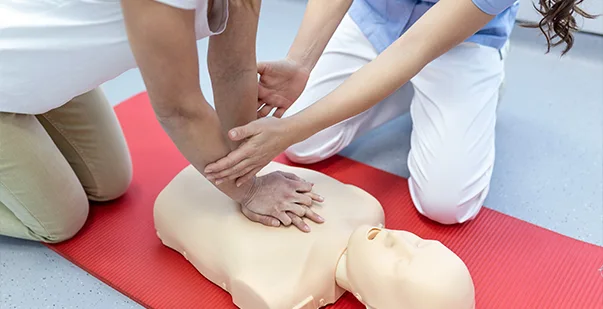Getting a CPR certification involves learning how and when to give cardiopulmonary resuscitation (CPR) to a victim. However, there is very little information that covers when to stop CPR. Knowing this is also crucial because it helps prevent unnecessary revival attempts, which may lead to further complications or physical harm to the victim.
Learning the necessary steps helps answer the question, “when should you stop CPR.” Cardiac arrest emergencies can happen anytime. That is why you may need further assistance to learn how to stop the process. Your skills may begin to diminish after six months despite being CPR-certified. Staying up to date using educational resources like articles can keep your CPR skills sharp.
This article will discuss four criteria for when to stop CPR and how you can use your training to avoid making mistakes in the field.
Master ACLS Now
Get ACLS certified with confidence
Understanding CPR
CPR is a crucial emergency lifesaving procedure performed when the victim’s heart stops beating. Immediate CPR can often double or triple the chances of the victim’s survival after cardiac arrest.
CPR keeps oxygen-rich blood flowing to the victim’s brain and other organs, which is why you must continue the process until the victim gets emergency medical treatment. A person’s body fails to receive oxygen-rich blood when the heart stops. It may even lead to brain damage within a few minutes.
Any trained person or healthcare professional can perform high-quality CPR. Their functionalities include:
- Minimizing interruptions in chest compressions
- Providing compressions of adequate depth and rate
- Avoiding leaning on the victim when giving compressions
- Ensuring proper hand placement
- Avoiding excessive ventilation
You should not give CPR to the victim if you do not have adequate training. The best action is to approach medical professionals as soon as possible.
Read More: CPR vs. BLS Training: What’s the Difference?
Four Criteria to Know When Do You Stop CPR
The sooner you start CPR, the better when it comes to providing basic first aid. However, you may need to stop it at some point due to various reasons. We will now discuss four reasons to stop CPR that can help you make informed decisions during an emergency.
-
The Victim’s Death
You must learn when to stop CPR and declare death in certain cases. A victim’s survival chance increases when you start CPR after a cardiac arrest. However, you may not witness this every time if the victim becomes unresponsive or dead. The deceased may also have non-viable injuries, like catastrophic brain trauma. You must assess the person to see if starting CPR is necessary when you encounter an unresponsive victim.
The signs include:
- Cold To the Touch
A victim is beyond rescue if their body has already gone cold. It is an indication that the person is already deceased. However, make sure to take your surroundings into account. Sometimes, the skin may give false indications if the person is a drowning victim or faints in cold weather. For instance, human bodies found in bed with several layers of blankets over them will feel very warm even if they have been dead for hours.
- Rigor Mortis
This is a recognizable sign of death that occurs due to chemical changes in the muscles post-mortem. This often causes the limbs of a corpse to stiffen. Rigor mortis can occur within four hours post-mortem in human beings. If you find a victim stiff with limbs that do not freely move, it is too late to start CPR.
- Livor Mortis (Lividity)
Livor mortis is the bluish color you may find on someone deceased for many hours. It happens due to blood settling and permeating the skin. It resembles bruising but may also cover portions of the human body. Lividity is commonly hidden either by clothes or seen when the person is rolled over. Regardless, it is a definitive sign of death if you recognize lividity in any victim.
- Injuries Not Compatible With Life
Examples of such injuries include decapitation and amputations of the torso. Several countries have protocols that discourage paramedics from starting CPR on any traumatic arrests in the body.
A traumatic arrest occurs when a victim has trauma that causes them to bleed excessively, leading their heart to go into cardiac arrest. Performing CPR is not possible in this circumstance because there is no blood to circulate with compressions or give rescue breaths.
-
Physical Fatigue
You cannot bring the victim back to life in just a few pumps in the chest. This may take you around 30 minutes to 1.5 hours to revive the person. Research also shows that longer resuscitation efforts improve brain function in survivors.
It also means you may witness physical fatigue during the process. CPR is tiring and causes you to lose almost 165 calories after 15 minutes of performing it. That is why you may need to stop after some time due to excessive fatigue if giving CPR by yourself.
You must be trained enough to know when to stop CPR when you become physically weak. Fortunately, there are no legal grounds to hold you liable in this situation.
-
Signs of Life
How long do you do CPR before calling time of death? The answer to this is looking for signs of life. CPR guidelines do not recommend reassessing for a pulse every two minutes, especially when performing a resuscitation process outside of advanced medical care. Once started, you must continue giving CPR as long as possible without interruption.
This involves looking for key signs of life as an indication of when to stop CPR. The primary signs include:
- Purposeful movement of victims, such as moving their arms, lifting their heads, or grimacing.
- Making sounds like moaning or speaking to let the rescuer know they are fine.
- Eye movement, where the victim can blink, look around, or focus on objects.
These signs of life may or may not occur in an out-of-hospital setting. You must resume performing CPR if the person becomes unresponsive again after you stop the process.
-
Arrival of Advanced Help
You may stop giving CPR to the victim once advanced help arrives. This assistance usually comes from a professional first responder, such as a paramedic or firefighter. These professionals may request that you continue doing compressions while they get their equipment in place. In other situations, they may ask you to stop so they can take over immediately.
Read More: First Aid for an Unconscious Person
FAQs in a CPR and Basic Life Support (BLS Module)
Learning when can you stop CPR is as essential as knowing how to perform it. The training modules for both CPR and BLS courses cover several crucial FAQs, including:
- Which of the following are valid reasons to stop CPR?
Understanding when to stop CPR is as important as knowing how to perform it. This topic covers all the valid reasons for discontinuing CPR. The common reasons include:
- Arrival of emergency medical personnel
- Signs of life shown by the victim
- Physical exhaustion of the rescuer
- Inability to continue performing effective CPR
- What are four reasons given in the lesson to stop BLS?
You may find several reasons to stop CPR or BLS, but the four crucial ones include:
- The victim shows Restoration of Spontaneous Circulation or ROSC signs. It is the resumption of a sustained blood flow through the body with crucial respiratory activity. Coughing, normal breathing, movement, and a noticeable pulse are the signs of ROSC.
- An advanced life support team takes over to care for the victim.
- The rescuer may not be able to continue because of exhaustion or an unsafe situation.
- A valid document asking for an immediate halt on the resuscitation process.
- Which of the following is not an indication to stop CPR once you have started?
The module provides you with four options to choose from when answering this question. These include:
- Pulse and respirations return
- You are physically exhausted
- A physician directs you to do so
- Care is transferred to a bystander
The correct answer is the fourth one: transferring the victim’s care to a bystander is not a valid reason to stop CPR.
- What are three reasons given in the lesson not to start BLS?
The CPR module also teaches you the reasons not to start BLS. These usually include:
- An unsecured scene where performing BLS may injure the rescuer
- Signs of biological death, such as rigor mortis
- A valid “Do Not Resuscitate” (DNR) order
Learning When to Stop CPR
CPR is a crucial first-aid process that enables you to save the lives of victims. The best way to learn about it is to pursue a CPR certification course from a reputed organization. Gathering these skills and knowledge can help you assist people in need until the arrival of medical assistance. So, does learning when to give CPR make you a professional in the field? No.
This is because you must also learn when to stop CPR in certain situations. Not all circumstances need resuscitation or compression attempts. That is why it is essential to understand the specific criteria for discontinuing CPR. This helps ensure that your efforts are both effective and appropriate in saving lives.







